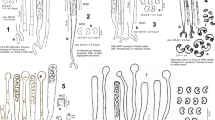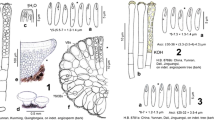Abstract
Orbilia georgiana and O. renispora are described as new species to science, in addition, O. eucalypti, O. occulta, and O. xanthoguttulata are reported based on collections taken from the state of Georgia, USA. Orbilia xanthoguttulata is a new record for North America. The morphology of all species is described based on both sexual and asexual morphs. Asexual morphs were obtained from ascospore isolates, from which also DNA was extracted and used to amplify rDNA genes (ITS and LSU) for phylogenetic comparison.






Similar content being viewed by others
References
Akata I, Dogan HH (2015) Orbiliaceae for Turkish ascomycota three new records. Bangladesh J Bot 44(1):91–95
Baral HO (1992) Vital versus herbarium taxonomy: morphological differences between living and dead cells of ascomycetes, and their taxonomic implications. Mycotaxon 44:333–390
Baral HO (1994) Comments on outline of the ascomycetes. Systema Ascomyc 13:113–128
Baral HO, Weber E, Gams W, Hagedorn G, Liu B, Liu XZ, Marson G, Marvanová L, Stadler M, Weiß M (2017) Generic names in the Orbiliaceae (Orbiliomycetes) and recommendations on which names should be protected or suppressed. Mycol Progr 17:5–31. https://doi.org/10.1007/s11557-017-1300-6
Eriksson OE, Baral HO, Currah RS, Hansen K, Kurtzman CP, Læssøe T, Rambold G (2003) Notes on ascomycete systematics Nos 3580–3623. Myconet 9:91–1032
Haelewaters D, Dirks AC, Kappler LA, Mitchell JK, Quijada L, Vandegrift R, Buyck B, Pfister DH (2018) A preliminary checklist of fungi at the Boston Harbor Islands. Northeast Nat 25(Special Issue 9):45–76
Jaklitsch W, Baral HO, Lücking R, Lumbsch HT (2016) Ascomycota. In: Frey W (ed) Engler’s syllabus of plant families, Part 1/2, 13th edn. Borntraeger, Stuttgart
Karasch P, Dämon W, Jaklitsch W, Baral HO (2005) Beiträge zur Pilzflora der Kanaren-Insel La Palma 2. Weitere bemerkenswerte Pilzfunde auf Chamaecytisus proliferus. Österr Z Pilzk 14:275–289
Li Y, Hyde KD, Jeewon R, Cai L, Vijaykrishna D, Zhang KQ (2005) Phylogenetics and evolution of nematode-trapping fungi (Orbiliales) estimated from nuclear and protein coding genes. Mycologia 97:1034–1046
Liu B, Liu XZ, Zhang WY (2005) Orbilia querci sp. nov. and its knob-forming nematophagous anamorph. FEMS Microbiol Lett 245:99–105
Liu B, Liu XZ, Zhang WY, Baral HO (2006) Orbiliaceous fungi from Tibet, China. Fungal Divers 22:107–120
Mo MH, Huang XW, Zhou W, Huang Y, Hao YE, Zhang KQ (2005) Arthrobotrys yunnanensis sp. nov., the fourth anamorph of Orbilia auricolor. Fungal Divers 18:107–115
Qiao M, Zhang Y, Li SF, Baral HO, Weber E, Su HY, Xu JP, Zhang KQ, Yu ZF (2012) Orbilia blumenaviensis and its Arthrobotrys anamorph. Mycol Progr 11(1):255–262
Qiao M, Li JY, Baral HO, Zhang Y, Qian WX, Su HY, Yu ZF (2015) Orbilia yuanensis sp. nov. and its anamorph. Mycol Progr 14:1–7
Quijada L, Baral HO, Beltran-Tejera E (2012) New species of Orbilia (Orbiliales) from arid ecosystems of the Canary Islands (Spain). Nova Hedwigia 96(1–2):237–248
Quijada L, Baral HO, Molina RJ, Weiss M, Pécastells JC, Beltran-Tejera E (2014) Phylogenetic and morphological circumscription of the Orbilia aurantiorubra group. Phytotaxa 175(1):001–018
Quijada L, Baral HO, Tejera EB (2015) Diversity of Hyalorbilia (Orbiliales) in the Macaronesian region. Nova Hedwigia 100(1):1–14
Quijada L, Baral HO, Beltrán-Tejera E (2016) A revision of the genus Orbilia in the Canary Islands. Phytotaxa 284:231–261
Ren YL, Liu B, Chen YL, Li JY (2014) Orbilia orientalis and its anamorph. J South China Agricult Univ 35(2):57–60
Su HY, Zhang Y, Baral HO (2011) Four new species of Orbiliaceae from Yunnan, China. Mycol Progr 10:373–381
Vilgalys R, Hester M (1990) Rapid genetic identification and mapping of enzymatically amplified ribosomal DNA from several Cryptococcus species. J Bacteriol 172:4239–4246
White TJ, Bruns T, Lee S, Taylor J (1990) Amplification and direct sequencing of fungal ribosomal RNA genes for phylogenetics. Academic Press, San Diego, pp 315–322
Yu ZF, Zhang Y, Qiao M, Baral HO, Weber E, Zhang KQ (2006) Drechslerella brochopaga, the anamorph of Orbilia (Hyalinia) orientalis. Mycotaxon 96:163–168
Yu ZF, Qiao M, Zhang Y, Baral HO, Zhang KQ (2007) Orbilia vermiformis sp. nov. and its anamorph. Mycotaxon 99:271–278
Yu ZF, Qiao M, Zhang Y, Qin L, Zhang KQ (2011) Pseudotripoconidium, a new anamorph genus connected to Orbilia. Mycologia 103(1):164–173
Zhang Y, Yu ZF, Baral HO, Mo MH, Zhang KQ (2009) New species and records of Orbilia (Orbiliaceae, Ascomycota) from China. Fungal Divers 36:141–153
Zhang Y, He XX, Baral HO, Qiao M, Weiβ M, Liu B, Zhang KQ, Yu ZF (2015) Orbilia laevimarginata sp. nov. and its asexual morph. Phytotaxa 203(3):245–253
Zhang Y, Zhang YR, Dong JY, He XX, Qiao M, Baral HO, Zhang KQ, Yu ZF (2016) Orbilia tianmushanensis sp. nov., a new member of the Orbilia luteorubella group with an unusual asexual morph. J Microbiol 54(1):9–13
Acknowledgments
The authors express their gratitude to the National Park Service for supporting and facilitating the Boston Harbor Islands Fungal Inventory, through which two collections of O. renispora were discovered under the permit number BOHA-2012-SCI-0009.
Funding
This work was supported by Project for Fundamental Research on Science and Technology, Ministry of Science and Technology of China (No. 2013FY110400), National Natural Science Foundation of China (No. 30860006), and Study Abroad Program for Excellent PhD Student of Guangxi Zhuang Autonomous Region of PR China.
Author information
Authors and Affiliations
Corresponding author
Ethics declarations
Conflict of interest
The authors declare that they have no conflict of interest.
Additional information
Section Editor: Marc Stadler
Electronic supplementary material
Fig. S1
ML phylogenetic tree based on ITS region sequence data. Hyalorbilia brevistipitata is used as outgroup. Branch support is given as maximum likelihood bootstrap percentages from 500 replicates. Bootstrap values less than 50% are not shown. Species included in this study are in bold (PDF 131 kb)
Fig. S2
ML phylogenetic tree based on partial LSU rDNA sequence data (D1–D2 domain). Hyalorbilia brevistipitata is used as outgroup. Branch support is given as maximum likelihood bootstrap percentages from 500 replicates. Bootstrap values less than 50% are not shown. Species included in this study are in bold (PDF 193 kb)
Rights and permissions
About this article
Cite this article
Shao, Y., Baral, HO., Ou, X. et al. New species and records of orbiliaceous fungi from Georgia, USA. Mycol Progress 17, 1225–1235 (2018). https://doi.org/10.1007/s11557-018-1438-x
Received:
Revised:
Accepted:
Published:
Issue Date:
DOI: https://doi.org/10.1007/s11557-018-1438-x




